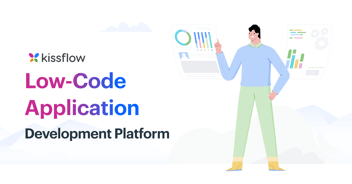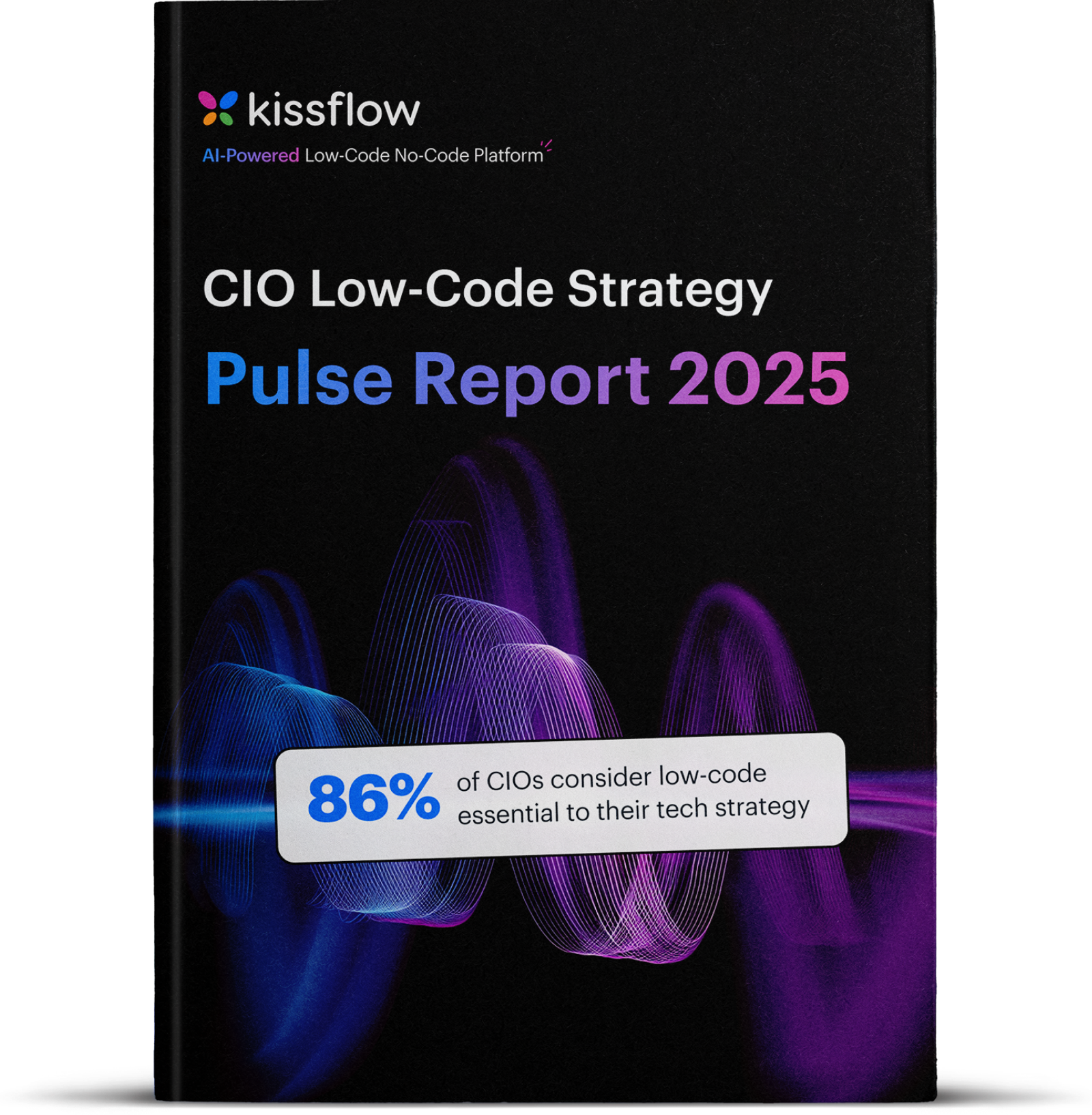CIOs aren't deciding between tools. They're deciding how to build for the future.
If you're a CIO or IT leader, your backlog isn't just a list—it's a signal. Every app request from HR, finance, or operations is someone raising their hand and saying, "This process needs fixing." Multiply that across departments, and you're looking at a mountain of operational inefficiencies waiting to be solved.
What do you prioritize first? And just as important, how do you solve them?
That's where the real question arises: Should you build or buy an application, or need a platform?
This blog discusses that decision. It provides a clear breakdown of platform vs. application, how they differ, and why many enterprise IT teams are shifting their focus from tools to platforms to scale faster, reduce cost, and maintain control.
What is an application?
An application is a piece of software designed to do one thing well. It might manage sales pipelines, track invoices, or collect feedback. Most enterprise teams are already using dozens, sometimes hundreds and also spend thousands of dollars on application development.
Here are some common examples:
-
CRM software like Salesforce
-
Project management apps like Asana or Trello
-
Expense-tracking apps like Expensify
-
HR tools for onboarding or performance reviews
These are focused, functional, and ready out of the box. That’s great if your need is simple and the problem is clearly defined.
However, applications tend to be rigid. Customizing them is often tricky, expensive, or impossible. That becomes a problem when business needs evolve faster than your tools can adapt.
A platform is like your internal software factory. It's the environment where you can build, run, and manage multiple applications, often tailored to your business's needs.
You’re not solving just one problem. You’re setting up a system that helps you solve dozens.
There are different kinds of platforms:
-
Enterprise platforms that support business-wide digital initiatives
-
Cloud-based SaaS platforms often help users create or manage business apps.
-
Low-code platforms, like Kissflow, let teams build apps with little to no coding.
Understanding these differences can help you avoid tech debt, reduce sprawl, and create more scalable systems.
Feature
|
Applications
|
Platforms
|
|
Purpose
|
Solves one specific problem
|
Solves multiple problems using a shared base
|
|
Customization
|
Limited, predefined
|
Highly customizable to business needs
|
|
Development Ownership
|
Usually external
|
Often internal or shared between teams
|
|
Scalability
|
Hard to extend beyond the original use case
|
Designed to scale with business growth
|
|
Integration
|
Often isolated or clunky
|
Built for cross-system integration
|
|
Cost
|
Priced per app, per module
|
Invest once and build many solutions
|
When comparing business platforms vs. software applications, it becomes clear that applications are best for focused needs. Platforms serve when you want to develop broadly, adjust quickly, and reuse components across teams.
When enterprises choose platforms
Flexibility and speed are crucial for growing companies. Most CIOs manage more than 50 internal software requests at any given time.
The system collapses if each solution needs its vendor, budget, integration, and security review.
That’s why many are moving toward enterprise platform vs. enterprise application strategies. What is the biggest value of an app development platform? It grows with you.
Benefits of using a platform:
-
Shared architecture: Instead of 20 tools with different user interfaces and rules, you manage everything in one environment.
-
Faster rollouts: With a low-code approach, IT and business teams can deliver apps in weeks instead of quarters.
-
Lower costs: Build once, reuse often. That means savings on both licensing and developer time.
-
Governance: Platforms give IT visibility into what's being built, by whom, and how it complies with company policies.
Example: The rise of low-code platforms
Let’s take the example of a low-code platform vs. application scenario.
A logistics company wants tools for:
-
Employee onboarding
-
Travel requests
-
Supplier registration
-
Internal audits
They could buy separate applications for each, meaning different workflows, inconsistent reporting, and siloed data.
Instead, they choose a low-code enterprise platform like Kissflow. Within a few months, they create all four apps using drag-and-drop forms, automated workflows, and standardized data sources. The apps look consistent, run on the same infrastructure, and are easy to maintain.
SaaS platform vs. application: Know the difference
SaaS platforms and applications are both cloud-based. But they serve different roles.
-
A SaaS application is a ready-made tool hosted in the cloud.
-
A SaaS platform lets you build, manage, and scale your tools in the cloud.
When deciding between a SaaS platform and an application, consider your need for control and flexibility. Applications are fast to deploy. But platforms give you room to grow and evolve.
The role of platforms in digital transformation
Real digital transformation is not about buying more tools. It’s about building a unified experience where systems, people, and data work together.
That’s where digital transformation with platforms stands out.
A well-chosen platform helps you:
-
Automate manual processes
-
Build and deploy apps at scale
-
Connect workflows across departments.
-
Reduce dependency on custom development.
-
Enable process owners to take the lead.
Platforms like Kissflow enable IT-led innovation and support citizen development while maintaining a strong governance framework.
Quick guide: When to pick a platform over an application
Business Scenario
|
Best Option
|
|
Solving one small, isolated task
|
Application
|
|
Handling multiple requests across departments
|
Platform
|
|
Reducing tool sprawl and vendor bloat
|
Platform
|
|
Empowering non-developers to build apps
|
Platform
|
|
Customizing processes quickly
|
Platform
|
|
Running a fixed-function process
|
Application
|
Why Kissflow leans into platforms, not just apps
At Kissflow, we see this daily: CIOs feel pressure to move faster while using fewer resources. The request volume keeps growing, but the dev bandwidth isn't.
We built our platform for the real work in the middle office—the stuff that's not glamorous but critical: procurement, vendor management, employee onboarding, and operations.
These aren’t problems you solve with one-size-fits-all apps. These are dynamic processes that shift with your business.
So we designed Kissflow to be:
-
Simple enough for process owners to build on
-
Flexible enough for IT to extend and support
-
Robust enough to meet compliance and governance needs
And we focus on backlog elimination because that’s where most enterprise IT leaders are stuck.
The future? It’s platform-first
Developers will build over 500 million apps in the next few years.—more than in the last 40 combined.
No IT team on the planet can build that many apps independently.
Enterprise success isn't about choosing the right app. It's about choosing the right foundation.
Kissflow's Platform let you scale your capacity to build, bring business and IT closer together, and stay ahead of the demand curve.
So next time a department head comes to you with a request, ask yourself—
Are we solving a problem today, or setting ourselves up to solve problems tomorrow, too?


![Different Types of Applications Explained in Detail [2025]](https://kissflow.com/hs-fs/hubfs/Types-of-Applications-Explained-2025.webp?width=352&name=Types-of-Applications-Explained-2025.webp)









